Posts by: Susan Curtis
Space weather: it’s all about impact
By Susan Curtis
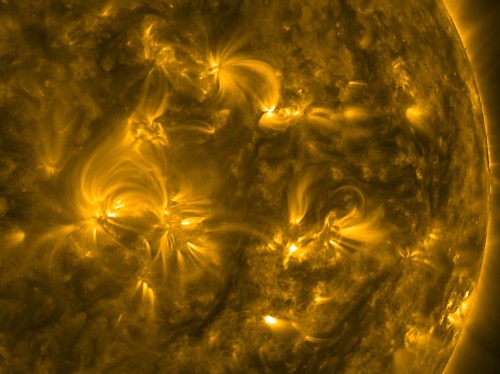
Dangerous affair – an extreme ultraviolet image of a tangle of arched magnetic filed lines in the Sun’s corona, taken in January 2016 by NASA’s Solar Dynamics Observatory. (Courtesy: Solar Dynamics Observatory, NASA)
We all love a good disaster movie, but when it comes to real life it’s all too easy to downplay a dangerous but distant threat. Many people choose to live on active volcanoes, the citizens of San Francisco know that “the Big One” could strike at any moment, and yet they believe that the benefits of living in those locations outweigh the risk of a severe event happening in their lifetime.
The same dilemma faces the community of scientists, engineers and policy-makers who are working to understand the impacts of space weather – changes in the Earth’s environment that are largely are driven by physical processes originating from the Sun. Space weather has the potential to disrupt or even damage critical infrastructures on Earth, such as the power grids, aviation routes and communication systems that modern societies depend on, but the last notable event dates back to 2003.
That’s why Mike Hapgood, who heads up the Space Weather Group at RAL Space, part of the UK’s Rutherford Appleton Laboratory, has written a new, free-to-read Physics World Discovery ebook called Space Weather. “I thought it would be a great opportunity to highlight what space weather is really about, and to show how we are linking our scientific knowledge to a better understanding of the impacts on society,” he comments.
View all posts by this author | View this author's profile
Russia’s Joint Institute of Nuclear Research builds for the future
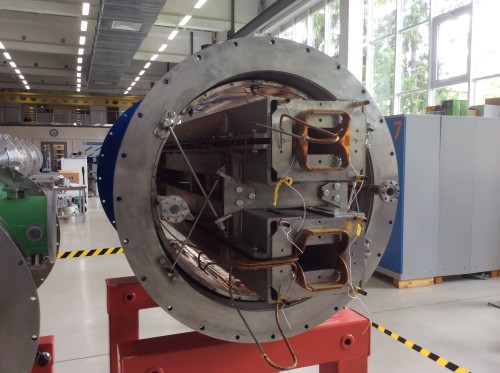
Zero resistance: the JINR is building superconducting magnets for both its new NICA facility and the FAIR heavy-ion collider being constructed at GSI Darmstadt.
By Susan Curtis
When our visit was running two hours behind schedule by lunchtime, I knew it was going to be a mind-expanding day. And there was certainly plenty to discover at the Joint Institute of Nuclear Research (JINR) in Dubna, some 120 km north-west of Moscow.
An international research centre bringing together 18 member states, the JINR has been in the news for its discovery of new superheavy elements (SHEs). According to Andrei Popeko, deputy director of the JINR’s Flerov Laboratory for Nuclear Reactions, all of the last six elements were first synthesized at the laboratory’s U400 cyclotron, in most cases using samples prepared at Oak Ridge National Laboratory in the US. The JINR is now building the world’s first SHE factory that will boost production efficiency by a factor of 50, which will allow the lab’s scientists to investigate the chemical properties of these short-lived elements.
View all posts by this author | View this author's profile
Russian bear opens its arms to international science
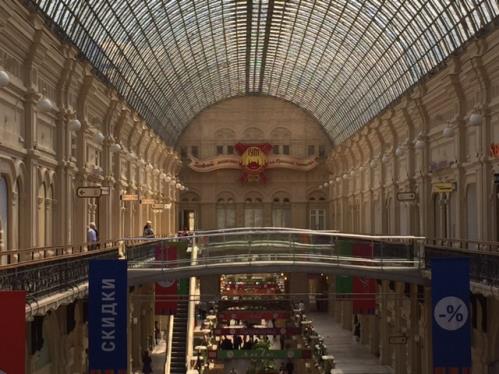
Free-market economic thinking is now being applied to Russia’s scientific sector. The GUM shopping centre in central Moscow. (Courtesy: Susan Curtis)
By Susan Curtis in Moscow
As an update to my last post, Russia’s deputy minister for science and education, Ludmila Ogorodova, accepted that the 1990s had been a period of crisis management for Russian science, and that in the 2000s plans for rebuilding the academic sector were hampered by lack of funding. But she also pointed to figures suggesting that Russian science has turned a corner over the past couple of years.
View all posts by this author | View this author's profile
Russian physics comes in from the cold
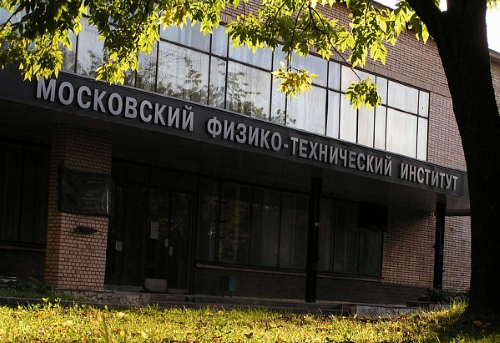
Physics powerhouse: the main building of the Moscow Institute of Physics and Technology. (Courtesy: Andrey Gusev)
By Susan Curtis in Moscow
It takes less than four hours to fly to Moscow from London, but it feels much more distant and mysterious. Even my colleagues at Physics World, who pride themselves on covering all of physics in all parts of the world, admit to a bit of a blind spot when it comes to Russian science, even though Russia has a strong tradition in physics as well as in mathematics and space science.
View all posts by this author | View this author's profile
Marking time on precision engineering

Adventures in science: the Magna centre in Rotherham, UK.
By Susan Curtis
At a time when the UK steel industry is close to meltdown, it felt quite humbling to be standing inside a disused steelworks on the outskirts of Rotherham. In its heyday in the 1970s the colossal plant employed 3000 people and housed six electric arc furnaces that set new records for steel production. Since closing in 1993, the facility has forged a new identity as the Magna Science Adventure Centre, which offers visitors an insight into the steel-making process and its heritage in the area around Sheffield.
Recently, I was at Magna for the annual TRAM conference, which showcases the latest technology advances in the aerospace industry. Organized by the Advanced Manufacturing Research Centre (AMRC), one of the UK’s Catapult centres based at the University of Sheffield and supported by Boeing, TRAM highlights how aircraft makers and their suppliers are improving materials and manufacturing processes to reduce cost and enhance performance. But among the talk of powder metallurgy, high-performance machining and the factories of the future, a presentation by Nick English from the UK-based watchmaker Bremont highlighted manufacturing innovation at a much smaller scale.
View all posts by this author | View this author's profile
Flying high in Baltimore
By Susan Curtis in Baltimore, US
After two days of getting to grips with biophysics – see here and here for my experiences – I was ready for a change of scene. And a visit to the Space Telescope Science Institute (STScI), co-located with the Johns Hopkins University in Baltimore but operated on behalf of NASA, was just what I needed.
The STScI is home to many of the scientists and engineers who made the Hubble Space Telescope possible, and who have been working for many years to design the optics and instrumentation for its successor – the James Webb Space Telescope (JWST), which is due to be launched in 2018. The institute also runs the science operations for Hubble and soon will for the JWST, providing software tools for astronomers to make their observations and processing the raw data acquired by the onboard instruments to make it ready for scientific analysis.
Big data offers biomedical insights
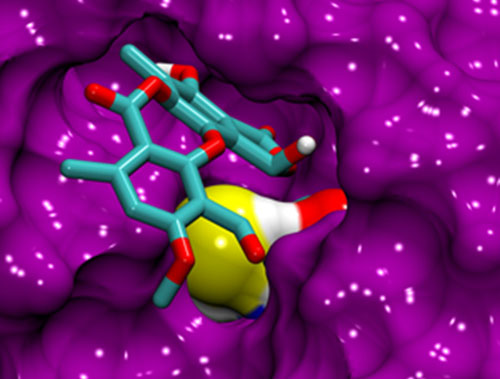
Suits you. This simulation of the p53 protein shows stictic acid fitted into the protein’s “reactivation pocket”. (Courtesy: Özlem Demir)
By Susan Curtis in Baltimore, US
At the 59th annual meeting of the Biophysical Society today, Rommie Amaro of the University of California, San Diego, highlighted the power of computational methods to speed up the discovery of new drugs to treat diseases as diverse as flu and cancer. Amaro focused on a recent project conducted while she was at the University of California, Irvine, to identify compounds that could play a vital role in future anti-cancer drugs by helping to reactive a molecule called p53 that is known to inhibit the formation of cancer cells.
View all posts by this author | View this author's profile
Physics meets biology in Baltimore
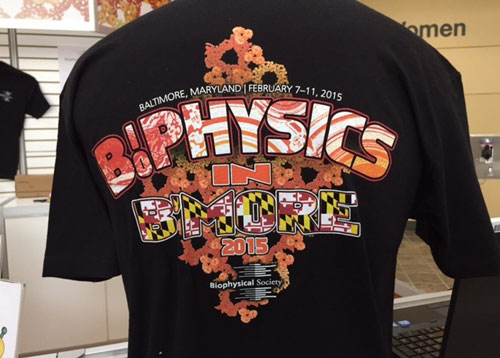
Biophysics in Baltimore: the T-shirt that does what it says on the tin.
By Susan Curtis in Baltimore, US
I’m in Baltimore this week for the 59th annual meeting of the Biophysical Society. The field of biophysics has grown rapidly in recent years as physics-based techniques have opened up new ways to study and understand biological processes, but with my limited knowledge of biology I was nervous that I would feel a little out of my depth.
The first talk of the “New and Notable” symposium helped to allay my fears. Michelle Wang is a physicist at Cornell University in the US who exploits optical techniques to trap and manipulate biomolecules. While established methods can only trap a single biomolecule at a time, Wang and her colleagues have pioneered the use of nanophotonic structures that can trap multiple biomolecules in a standing wave created within an optical waveguide.
“Our optical-trapping innovation reduces bench-top optics to a small device on a chip,” Wang told physicsworld.com when the team first reported their so-called nanophotonic standing-wave array trap last year. Since then, Wang and her colleagues have been working to integrate fluorescent markers with the nanophotonic trap to track the position of individual biomolecules, and have also been experimenting with optical waveguide materials other than silicon to improve performance and enable new applications.
View all posts by this author | View this author's profile
Physics road trip through the north-east of Brazil

Susan Curtis (left), Sarah Andrieu (centre) and Alvaro Ferraz admire the new IIP building in Natal.
By Susan Curtis
This week, several of us from IOP Publishing have been visiting the north-east of Brazil. Our prime focus has been the annual meeting of the Brazilian Materials Research Society in João Pessoa, where we launched a new Science Impact report highlighting materials research in Brazil. But during the week I travelled to Natal with my colleague Sarah Andrieu to visit Alvaro Ferraz, director of the International Institute of Physics (IIP).
View all posts by this author | View this author's profile
Postcard from Campinas – the site of Brazil’s future synchrotron

Artist’s impression of Brazil’s Sirius synchrotron source. (Courtesy: LNLS)
By Susan Curtis in Campinas, Brazil
For the first time this week I woke to a brilliant blue sky, and below my hotel room I could see young Brazilians enjoying a quick game of football in the relative cool of the morning. Away from the traffic jams and unseasonably wet weather of the past few days, this seemed much more like the image of Brazil that’s projected to the outside world.
Today I was in Campinas, the third largest city in the state of São Paulo, some 100 km north-east of São Paulo itself. On the outskirts of the city is the National Center for Energy and Materials (CNPEM), home to Brazil’s synchrotron source as well as three national laboratories for nanotechnology, biosciences and ethanol production – which is a big deal for Brazil, since it offers a way to produce fuel from its abundant sugar cane.
View all posts by this author | View this author's profile